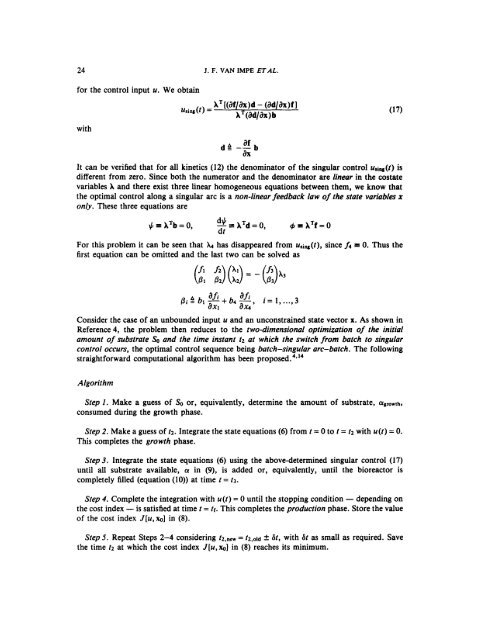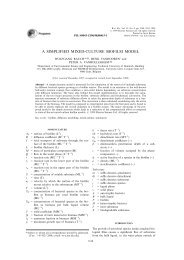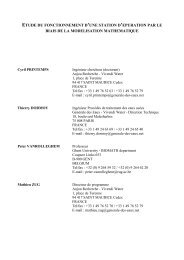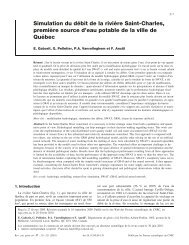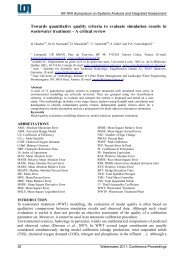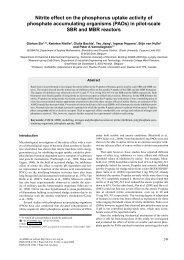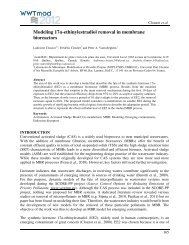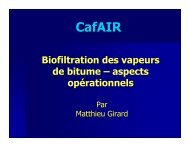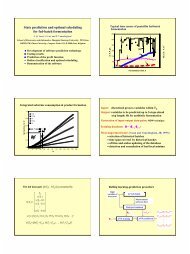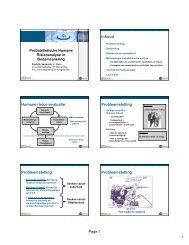24 J. F. VAN IMPE ETAL.for <strong>the</strong> <strong>control</strong> input u. We obtainwithdkaf--baxIt can be verified that for all kinetics (12) <strong>the</strong> denominator <strong>of</strong> <strong>the</strong> singular <strong>control</strong> uri,(t) isdifferent from zero. Since both <strong>the</strong> numerator and <strong>the</strong> denominator are linear in <strong>the</strong> costatevariables X and <strong>the</strong>re exist three linear homogeneous equations between <strong>the</strong>m, we know that<strong>the</strong> optimal <strong>control</strong> along a singular arc is a non-linear feedback law <strong>of</strong> <strong>the</strong> state variables xonly. These three equations are3 zz Xfd = 0,dt$t = X'b = 0, 6 = X'f = 0For this problem it can be seen that XS has disappeared from Usiw(t), since fs = 0. Thus <strong>the</strong>first equation can be omitted and <strong>the</strong> last two can be solved as(" 01 f2) 02 (XI) Xzafiafi= - (;)A3pi bl - + b4 -, i = 1, ..., 3ax,ax4Consider <strong>the</strong> case <strong>of</strong> an unbounded input u and an unconstrained state vector x. As shown inReference 4, <strong>the</strong> problem <strong>the</strong>n reduces to <strong>the</strong> two-dimensional optimization <strong>of</strong> <strong>the</strong> initialamount <strong>of</strong> substrate SO and <strong>the</strong> time instant t2 at which <strong>the</strong> switch from <strong>batch</strong> to singular<strong>control</strong> occurs, <strong>the</strong> optimal <strong>control</strong> sequence being <strong>batch</strong>-singular arc-<strong>batch</strong>. The followingstraightforward computational algorithm has been pr~posed.~*'~AlgorithmStep I . Make a guess <strong>of</strong> SO or, equivalently, determine <strong>the</strong> amount <strong>of</strong> substrate, CYgmwth,consumed during <strong>the</strong> growth phase.Step 2. Make a guess <strong>of</strong> 22. Integrate <strong>the</strong> state equations (6) from t = 0 to t = t2 with u(t) = 0.This completes <strong>the</strong> growth phase.Step 3. Integrate <strong>the</strong> state equations (6) using <strong>the</strong> above-determined singular <strong>control</strong> (17)until all substrate available, a in (9), is added or, equivalently, until <strong>the</strong> bioreactor iscompletely filled (equation (10)) at time t = 23.Step 4. Complete <strong>the</strong> integration with u(t) = 0 until <strong>the</strong> stopping condition - depending on<strong>the</strong> cost index - is satisfied at time t = Cf. This completes <strong>the</strong> production phase. Store <strong>the</strong> value<strong>of</strong> <strong>the</strong> cost index J[u,xo] in (8).Step 5. Repeat Steps 2-4 considering t2,new = t2,old 2 62, with 6t as small as required. Save<strong>the</strong> time f2 at which <strong>the</strong> cost index J[u,xo] in (8) reaches its minimum.
PENICILLIN G FED-BATCH FERMENTATION 25Step 6. Repeat Steps 1-5 with a new guess <strong>of</strong> SO in order to minimize J[u, XO].For <strong>the</strong> performance measure under consideration, equation (8), it can be easily shown (byusing (14) and (16)) that <strong>the</strong> stopping condition for this case is dP/dt(tr)=O, as could beexpected. In <strong>the</strong> case <strong>of</strong> a constraint on <strong>the</strong> <strong>control</strong> u and/or <strong>the</strong> state vector x, only someminor modifications are required, <strong>the</strong> algorithm itself remaining a two-dimensional search. Adetailed analysis <strong>of</strong> this algorithm in comparison with <strong>the</strong> algorithm proposed by Lim et al. l5toge<strong>the</strong>r with a verification <strong>of</strong> all necessary conditions for optimality can be found inReference 4. The main difference from <strong>the</strong> algorithm <strong>of</strong> Lim et al. is that we do not make use<strong>of</strong> <strong>the</strong> costate variables, whatever <strong>the</strong> performance index under consideration.3.2. Simulation resultsWe now present some results obtained with <strong>the</strong> above computational algorithm. Weconcentrate on two specific values <strong>of</strong> <strong>the</strong> parameter B (i) B = lo-" as an approximation <strong>of</strong><strong>the</strong> original Blackman-type kinetics (3) and (ii) <strong>the</strong> o<strong>the</strong>r extremal value B = krit = lo-', where~ ( p reduces ) to <strong>the</strong> Monod-type law (13).3.2.1. B = 10-". In <strong>the</strong> left plot <strong>of</strong> Figure 4 we have visualized <strong>the</strong> actions taken by <strong>the</strong>For every SO <strong>the</strong> optimal switch time t2 has beencomputational algorithm for B= lo-''.calculated. As a consequence, we obtain <strong>the</strong> corresponding values for P(tr) and tr. Clearly, <strong>the</strong>optimal couple (&*, t;) is <strong>the</strong> one which maximizes P(tr). Observe <strong>the</strong> quadratic behaviour <strong>of</strong>P(tr) as a function <strong>of</strong> SO, so that <strong>the</strong>re exists a unique optimal solution to this problem.Observe that <strong>the</strong>re exists a lower limit Smin on <strong>the</strong> possible values for SO, corresponding totz = 0. In that case <strong>the</strong> complete initial state xo is on <strong>the</strong> singular hyperplane, so singular<strong>control</strong> starts immediately. Note that SO = a corresponds to a complete <strong>batch</strong> <strong>fermentation</strong>:tr = t3 = tz, with u(t) = 0 for ali t. Even for values <strong>of</strong> SO in <strong>the</strong> neighbourhood <strong>of</strong> a, <strong>the</strong>condition dP/dt = 0 is never met before t = t2. As a result, we can indeed apply <strong>the</strong> proposedcomputational algorithm to <strong>the</strong> whole possible range SO E [Smin, a]. A derived benefit is <strong>of</strong>course that a good starting value for SO is not required for <strong>the</strong> algorithm to converge. Somenumerical values for <strong>the</strong> optimal <strong>control</strong> are summarized in Table 11. The right plot <strong>of</strong> Figure 4100 0.2 0.4 0.6 0.8 1 1.2 1.4 1.6 1.8 2s(w Id1.LO+Figure 4. B= lo-". Left plot: extremal values for P(tf), t2 and tf as functions <strong>of</strong> SO. Scaling: tJSO, rf/500,(P(tr) - 8150)/180. Right plot. optimal glucose feed rate and corresponding cell, glucose, product, T- and p-pr<strong>of</strong>iles.Scaling: c, x 300, c, x 5, q103, p x 100, r x 2 x lo4, u/300Time [h]


